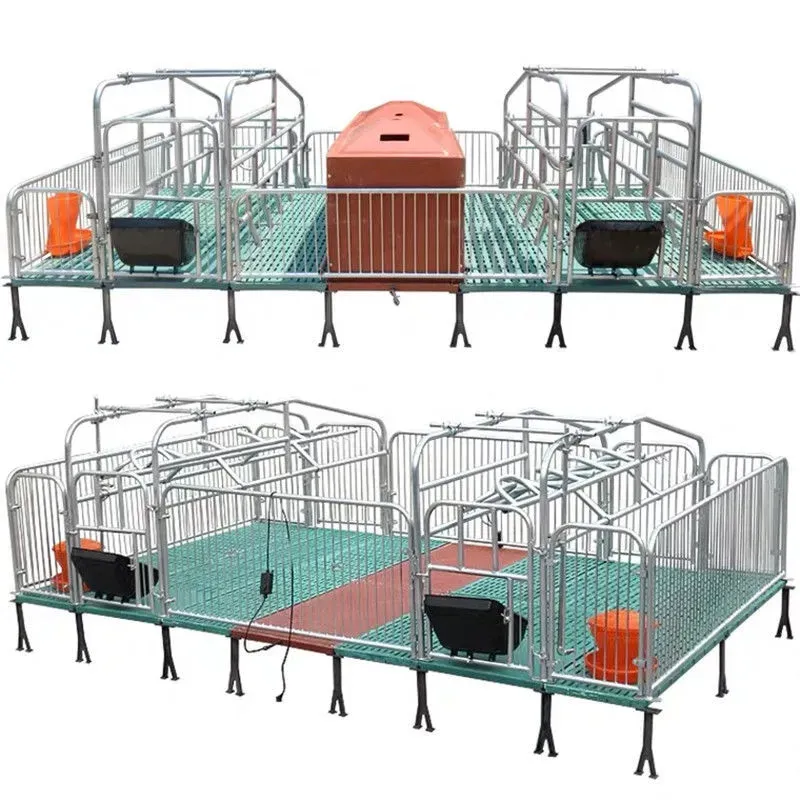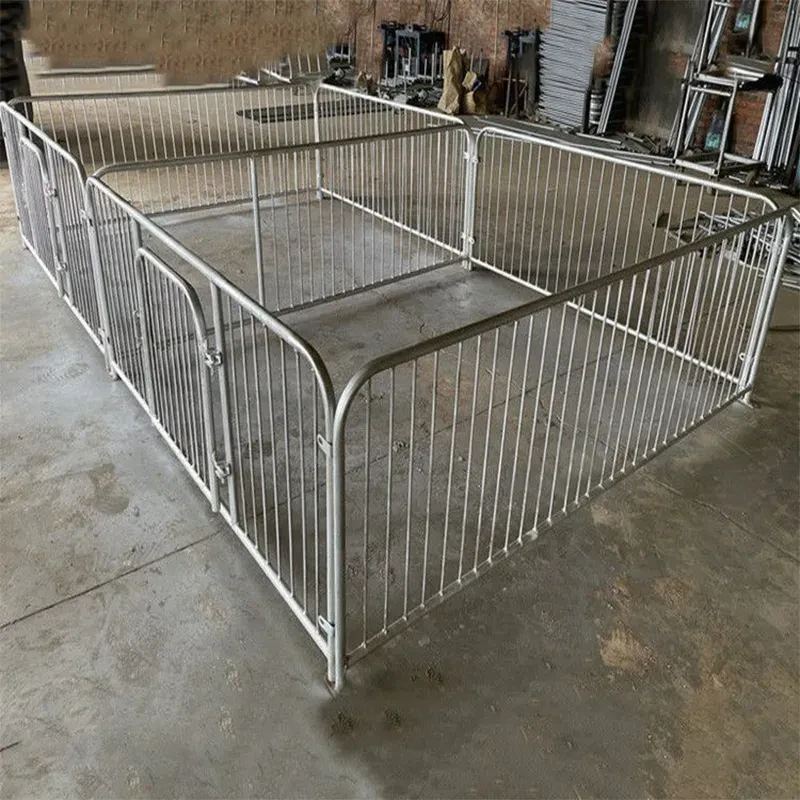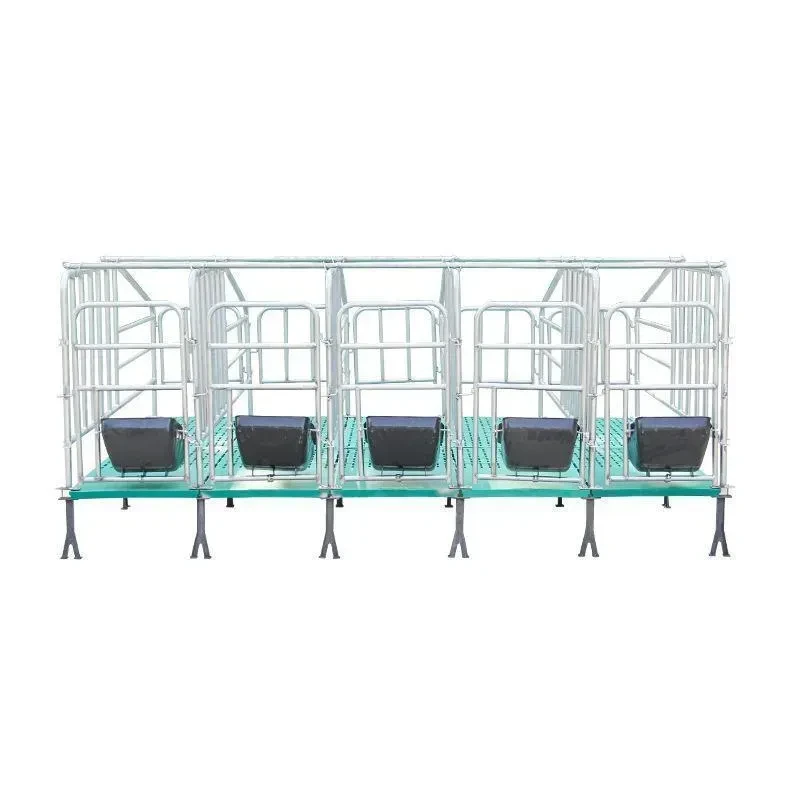Our specialized pig housing systems are engineered to address the distinct needs of different production stages while maximizing animal welfare and operational efficiency. The sow gestation pen is designed with precision to support pregnant sows throughout their critical 115-day gestation period. These pens incorporate individual feeding stations with controlled rationing systems to ensure proper nutrition while preventing aggressive competition. The innovative layout provides adequate space for movement while maintaining a structured environment that reduces stress and minimizes injuries. Constructed from heavy-duty, corrosion-resistant materials, these pens feature smooth surfaces and secure partitions to protect both animals and handlers.
For farrowing operations, our farrowing pens for pigs create an ideal environment for sow and piglet safety during this vulnerable phase. The pens integrate protective railings to prevent crushing while allowing easy nursing access, significantly improving piglet survival rates. The heated creep area maintains optimal temperature for newborns, complementing the sow's natural warming ability. Slatted flooring with proper drainage ensures hygiene by separating piglets from waste, while removable panels facilitate effortless cleaning and disinfection between farrowing cycles.
Both pen systems incorporate smart design elements that align with modern animal welfare standards while addressing practical farm management needs. The gestation pens promote sow health through controlled movement and feeding, while the farrowing pens focus on creating a safe, thermally regulated microclimate for neonatal pigs. These solutions demonstrate our commitment to developing housing systems that enhance productivity through science-based designs, ultimately supporting profitable and sustainable pork production operations.
Key Functions of Farrowing Pens
Farrowing pens play a critical role in swine production by providing a controlled environment that ensures the safety and well-being of both sows and piglets during the vulnerable farrowing and lactation periods. One of the primary functions is piglet protection, as newborn piglets are highly susceptible to crushing by the sow. Modern farrowing pens incorporate features such as anti-crush bars or sloped sides that encourage the sow to lie down carefully, reducing the risk of accidental piglet mortality. Additionally, the pens create a designated creep area—a heated, enclosed space where piglets can retreat to stay warm and safe when not nursing. This area is essential because piglets lack sufficient body fat at birth and require supplemental heat to maintain their body temperature.
Another vital function is hygiene management. Farrowing pens are designed with slatted or perforated flooring that allows waste to fall through, keeping the living space clean and dry. This design minimizes bacterial growth and reduces the risk of infections, which is crucial for piglet survival in the first few weeks of life. Many pens also include removable panels or gates, making it easier for farmers to clean and disinfect the area between farrowing cycles.
The pens also facilitate efficient sow management. They are structured to restrict excessive movement of the sow while still providing enough space for her to stand, lie down, and nurse comfortably. This controlled movement helps prevent injuries to both the sow and her piglets while ensuring that the sow can access feed and water without difficulty. Some advanced farrowing pens incorporate automated feeding and watering systems, reducing labor requirements and ensuring consistent nutrition for the lactating sow.
Lastly, farrowing pens support monitoring and veterinary care. Their design allows farmers to easily observe the sow and piglets for signs of distress, illness, or complications during farrowing. Quick intervention can then be taken if needed, improving overall litter survival rates.
Factors to Consider When Choosing or Designing a Farrowing Pen
Selecting or designing an effective farrowing pen requires careful consideration of several factors to ensure it meets the needs of both the animals and the farm operation. One of the most important considerations is animal welfare. The pen must provide enough space for the sow to move comfortably while also incorporating safety features like anti-crush rails to protect piglets. The layout should allow the sow to stand, lie down, and nurse without restriction, as prolonged discomfort can lead to stress and reduced milk production.
Durability and materials are also critical. Farrowing pens should be constructed from high-quality, non-corrosive materials such as galvanized steel or reinforced plastic that can withstand frequent cleaning and prolonged use. The flooring must be designed to prevent slipping and injuries, with options like slatted floors for waste removal or rubber mats for added comfort.
Climate control is another key factor, particularly in regions with extreme temperatures. The pen should include features such as adjustable ventilation, heating lamps, or cooling systems to maintain an optimal environment for the sow and piglets. Overheating can stress the sow, while cold drafts can endanger piglets, so proper insulation and temperature regulation are essential.
Ease of cleaning and maintenance should not be overlooked. Pens with removable partitions, smooth surfaces, and efficient waste disposal systems help reduce labor and ensure hygiene. A design that allows for quick disinfection between farrowing cycles minimizes disease risks and improves biosecurity.
Finally, cost and scalability must align with the farm’s budget and long-term goals. While advanced automated systems may be ideal for large commercial operations, smaller farms might prioritize simpler, cost-effective designs that still meet basic welfare and functionality standards.
Why Swine Farmers Use Pig Farrowing Crates
Swine farmers widely use pig farrowing crates because they offer a practical solution to some of the biggest challenges in piglet production, particularly in reducing mortality rates and improving operational efficiency. One of the primary reasons for their use is piglet survival. Newborn piglets are extremely vulnerable to being accidentally crushed by the sow, especially in the first few days after birth. Farrowing crates are designed with restrictive bars or adjustable sides that limit the sow’s movement, preventing her from rolling over onto the piglets while still allowing her to stand, lie down, and nurse comfortably. Studies have shown that farrowing crates can significantly reduce pre-weaning mortality rates, making them indispensable for profitable swine farming.
Another reason is biosecurity and disease control. Farrowing crates keep sows and piglets in a controlled, cleanable environment, minimizing exposure to pathogens. The confined space makes it easier to implement strict hygiene protocols, such as regular disinfection and waste removal, which are crucial for preventing outbreaks of diseases like diarrhea or respiratory infections.
Labor efficiency is also a major advantage. Farrowing crates simplify tasks such as feeding, health checks, and piglet processing (e.g., vaccinations, tail docking, and iron injections). Many modern crates are integrated with automated feeding and watering systems, further reducing the time and effort required for daily management.
Despite ongoing debates about animal welfare, many farmers argue that properly designed farrowing crates strike a balance between sow comfort and piglet safety. Innovations such as temporary confinement systems—where sows are only restricted during the immediate post-farrowing period—are gaining traction as a compromise between welfare concerns and practical farming needs.













